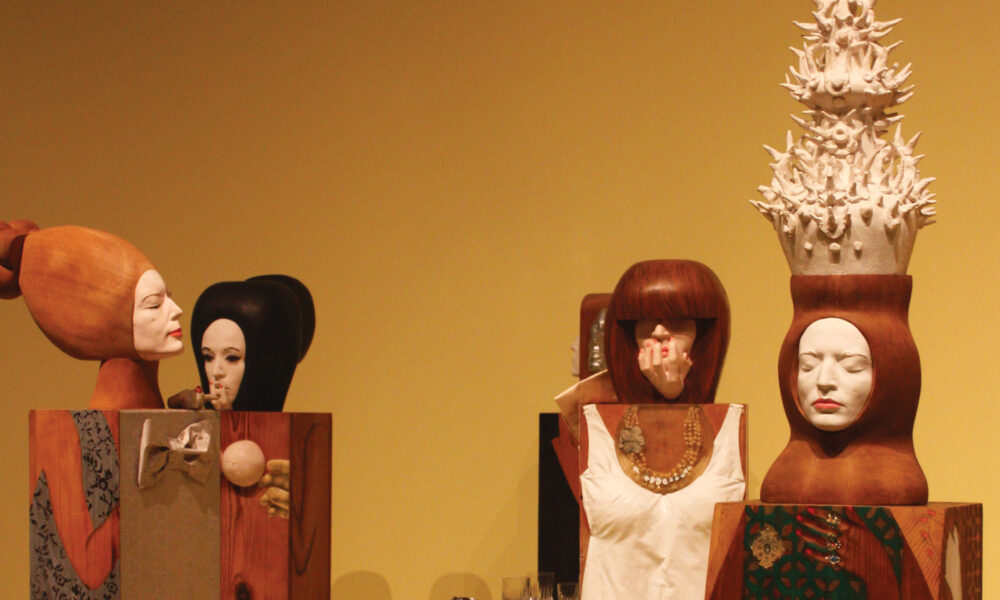The artist Marisol was a 1960s pioneer, with Warhol-like pop art and sculptures that highlight the role of women in society. Open as of Oct. 7 at the Montréal Museum of Fine Arts (MMFA), Marisol: a retrospective highlights works from Marisol Escobar, a Venezuelan-American artist known for her massive, striking wooden sculptures. After its run in Montréal, the Marisol exhibit, organized by the Buffalo AKG Art Museum in New York, will travel to the Toledo Museum of Art, the Buffalo AKG Art Museum, and the Dallas Museum of Art.
The exhibit follows Marisol’s life’s work, starting chronologically from the 1950s to the end of her career in the mid-2010s. Her artwork fills an entire floor and is sectioned into six rooms—Material Experimentations, Mutable Forms, Mutable Selves, Self and Society, Into the Swim, Troubling Doubles, and Portraiture, from the Personal to the Political—that showcase the unique focuses of family, connection, and marginalization in her sculptures.
“I want people, even if they’ve never heard of Marisol before, to come away with a sense that [Marisol] is a truly visionary artist whose work is deeply relevant to us today,” Cathleen Chaffee, the Chief Curator of Buffalo AKG Art Museum, said in an interview with The Tribune.
After climbing the MMFA’s elegant staircase, the first sculpture one sees is Mi Mama y Yo (1968), which depicts an 11-year-old Marisol and her mother, Josefina Hernández Escobar. This piece introduces the viewer to her art style, which combines bold colours with cubic wooden people—each person connected by their geometry and symmetry. Huge geometric wooden blocks and bronze faces form both figures. Marisol’s body has a slightly lighter shade of pink paint than her mother, but their faces could be of the same mould. This creates a duplicate effect which echoes within her portrayals of people throughout the exhibit. Her mother tragically passed away when she was eleven, which inspired the sculpture of them side-by-side. This first look is raw and authentic, establishing the poignant and devastating themes that Marisol explores within her work.
Another striking sculpture, Baby Girl (1963), depicts a six-foot-tall wooden baby, adorned with a white bow and fringe. Minute in comparison, a small wooden mannequin standing on the baby’s thigh represents Marisol. Most of her sculptures are taller than those viewing them, the baby being a prime example of this distortion. The enormous infant reflects the immense pressure on mothers, the responsibility of raising children towering over them just as the baby comically towers over the mannequin. Marisol used this sculpture to foster empathy with caregivers and families. It visualizes the pressure on women to have children, which Marisol faced herself: She never had children but would often be asked when she would. Baby Girl epitomizes Marisol’s intent to bring light to women’s struggles, and similar feminist themes can be seen throughout the exhibition.
“Looking from our position today, when we think so much about women’s roles, understanding of self, feminist issues, and ecological issues; [Marisol is] approaching all of those concerns and questions through her own subjectivity,” Chaffee said. “She makes herself vulnerable as a way of understanding the tropes we need to address.”
Journeying through each room, the larger-than-life wooden sculptures form a garden of statues, making the visitor feel humbled and small. The exhibit also includes sketches and drawings from Marisol’s childhood to her later years, providing viewers a glimpse into her growth as an artist throughout her life. There are films, also, one of which she made with Andy Warhol, that give the exhibit a fuller, dynamic experience. Additionally, quotes from Marisol pop up along the walls, giving context to her pieces. With each sculpture that highlights issues we still face today, she urges people to find solace in one another, and have empathy and meditation for the struggles of marginalized people.
Marisol: a retrospective runs at the MMFA until Jan. 21, 2024.








